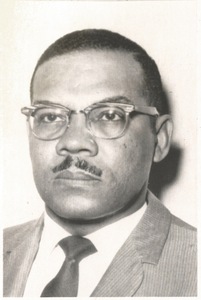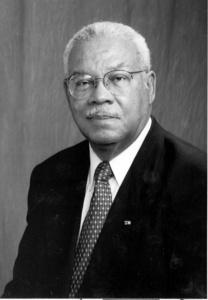The first image, which dates to 1968, is a photograph of Gilbert Rutledge Mason, MD, one of the first African-American members of the Mississippi State Medical Association, who also was known as the Mississippi Gulf Coast’s “Civil Rights Doctor.” He was born in Jackson on October 7, 1928, and was reared there, graduating from Tennessee State University in Nashville in 1949 and completing medical school at Howard University College of Medicine in 1954. After his year internship at Homer G. Phillips Hospital in St. Louis, Mason returned to Mississippi with his wife, Natalie, in July 1955 to begin his practice of family medicine in Biloxi. He treated patients not only at his clinic but also at the local hospital, having obtained access to a special annex of the hospital. In addition to his vigorous work as a physician, Mason became a vital leader in Mississippi’s civil rights struggle, initiating the state’s first civil disobedience as organizer of the Biloxi beach wade-ins. On May 14, 1959, he and several other locals walked on the Biloxi beach, which was then segregated, and waded into the Gulf. He and his group were ordered to leave the area by the city police. Mason formed the Harrison County Civic Action Committee, which would over eight years lead massive nonviolent protests with the intention of integrating the Gulf Coast’s beaches. On April 24, 1960, Mason led more than one hundred black men, women, and children in a nonviolent wade-in on a white-only area of Biloxi beach. This wade-in is considered by historians as Mississippi’s first civil disobedience and nonviolent direct-action protest in the civil rights era. The group was met with mob of white protestors, a confrontation promptly described by The New York Times as “the worst race riot in Mississippi history.” The incident attracted the attention of the National Association of the Advancement of Colored People (NAACP) state organizer Medgar Evers, who worked closely with Mason to establish a Biloxi chapter of the NAACP, with Mason becoming its first and longtime president. Mason’s group, aided by leadership from the federal government, filed an antidiscrimination lawsuit against Mississippi and thereby successfully opened Harrison County’s twenty-six mile long public beach to the full use of all citizens by 1968.
Although history remembers Mason largely as a medical doctor and the organizer of the Biloxi beach wade-ins, few Americans were more actively engaged in the struggle for civil rights in Mississippi than he was. Mason initiated local voter registration drives, worked to integrate the counters of local Gulf Coast restaurants, and filed suit (with twenty-one other parents) to integrate Biloxi’s public school system in 1963. This suit was successful, and peaceful school integration occurred in Biloxi in August 1964. During the civil rights struggle, his medical office was fire-bombed, and his practice was subjected to smear campaigns.
This first photograph, mentioned above, is a press photo of Mason dated June 11, 1968. Its cutline reads: “DEMOCRATIC DELEGATE FROM MISSISSIPPI— Dr. Gilbert Mason, a Biloxi, Miss., physician long active in civil rights work, will be the first member of his race to represent Mississippi at the National Democratic Convention in Chicago.” The image features the forty-year-old physician at the peak of his civil rights activism and medical work. This was also the time he joined the MSMA as one of its first Black full-voting members and its first Black state delegate as well. Also, selected with him to serve as one of the first African Americans on the regular Mississippi Democratic delegation was Dr. Matthew J. Page of Greenville. Page is also remembered with Mason as one of the first African-American MSMA members, becoming both an early scientific member and a full voting member in 1966. Mason would remember in his memoir* that being elected as a regular Democratic delegate from the state was a major step forward for civil rights in the state and nation. He commented, “These outcomes guaranteed that, for the first time in history, there would be blacks in the Mississippi delegation at the Democratic National Convention.” Despite these outcomes, Mason and Page would not be allowed to serve in Chicago after a contentious split at the state party convention, in which the “Freedom Democrat” or “Loyalist” delegation sought to unseat the “Regular” delegation. Mason sought a compromise to unite the two delegations and in the end was not seated in Chicago. However, his election as a “Regular” delegate paved the way for a more united state convention in 1972, which included Mason as a national convention delegate.
Drs. Mason and Page would make history again in 1980 when Governor William Winter appointed them to the new nine-member Mississippi State Board of Medical Licensure, this body having been separated from the Board of Health. Mason continued to battle for civil rights in his community and state for the rest of his life, serving in a variety of important leadership and board roles. Mason reflected in his memoir: “In my medical practice, and in my experiences of public service, I have seen that individual relationships built one-on-one are capable of helping many of us bypass or rise above the tendency to view others exclusively through a racial filtering lens. Reaching for each other as individuals, we can often connect with that common humanity that lives just beneath the surface.”
The second photograph, dated June 23, 1963, shows another Mason-led Biloxi beachfront demonstration. Seventy-one marchers nonviolently protested the slow pace of local integration. Although no white mobs disrupted the event, police did arrest all seventy-one demonstrators. In this image, which was taken by Mr. Leo M. Russell, helmeted police officers escort the first in a line of demonstrators off the beach. The final photograph shows Dr. Mason in 1997 at the end of a long and successful medical and civil rights career.
Dr. Mason died in Biloxi on July 8, 2006. In 2009, the Mississippi Department of Archives and History dedicated a historical marker to Mason in Biloxi. *For more on Dr. Mason, see his excellent memoir which was co-written with James Patterson Smith, Beaches, Blood, and Ballots: A Black Doctor’s Civil Rights Struggle (2000) and also my essay “Opening the Doors of the Great Republic: Sex, Race, and Organized Medicine” in The Racial Divide in American Medicine: Black Physicians and the Struggle for Justice in Health Care, edited by Rick deShazo (2018). If anyone has a photograph of Dr. Matt Page of Greenville, I would love to include it in a coming column. Also, if you have an old or even somewhat recent photograph which would be of interest to Mississippi physicians, please send it to me at drluciuslampton@gmail.com or by snail mail to the Journal. — Lucius M. “Luke” Lampton, MD; JMSMA Editor






